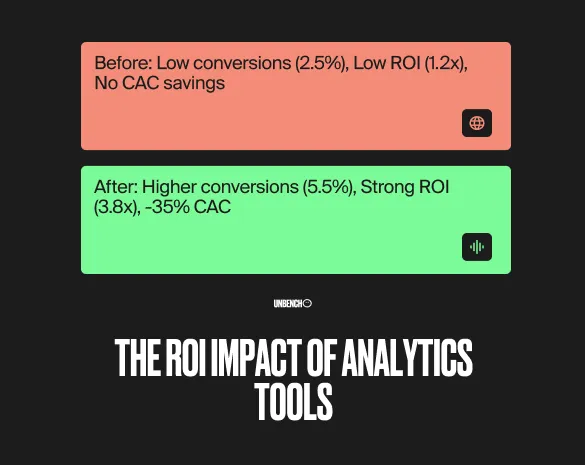In today’s digital-first world, data isn’t just a byproduct of marketing campaigns — it’s the foundation for making the right decisions. Without reliable analytics and tracking tools, marketers risk wasting ad spend, missing key audience insights, and failing to prove ROI to stakeholders.
As we move into 2025, the demand for smarter, AI-driven, privacy-compliant tools is stronger than ever. The best marketing teams no longer rely on one platform alone — they combine multiple solutions to cover web analytics, attribution, customer journeys, and performance tracking.
Here are the 7 best analytics and tracking tools every marketer should consider in 2025.
.webp)
1. Google Analytics 4 (GA4)
Google Analytics 4 remains the backbone of most marketing teams’ reporting stack. Its move away from cookie-based tracking toward event-driven data models makes it a must-have in a privacy-first era.
Best for: Website and conversion tracking at scale.
Key Features:
- Event-based tracking for more accurate attribution
- Cross-platform analysis (web + mobile apps)
- AI-powered predictive metrics (churn probability, purchase likelihood)
- Integrations with Google Ads and BigQuery
Pros:
✔ Free and widely adopted
✔ Rich integrations with Google ecosystem
✔ AI insights help optimize campaigns
Cons:
✘ Steep learning curve for non-technical users
✘ Some advanced features require BigQuery setup
2. Mixpanel
Mixpanel shines when it comes to product analytics. Unlike GA4, which is better for traffic and campaigns, Mixpanel focuses on user journeys and retention.
Best for: SaaS, apps, and B2B products.
Key Features:
- Funnel and cohort analysis
- Behavioral analytics to track product engagement
- Real-time dashboards
- Easy segmentation of users
Pros:
✔ Great for understanding customer journeys
✔ User-friendly dashboards
✔ Strong retention analytics
Cons:
✘ Expensive for large teams
✘ Requires clear event setup
3. Hotjar
For marketers who want to move beyond numbers, Hotjar offers behavioral tracking through heatmaps, session recordings, and surveys.
Best for: UX optimization and CRO (conversion rate optimization).
Key Features:
- Heatmaps of clicks, scrolls, and movements
- Session recordings for user behavior insights
- On-site feedback and surveys
- Funnel tracking
Pros:
✔ Easy to install and use
✔ Combines qualitative and quantitative data
✔ Ideal for website UX improvements
Cons:
✘ Limited analytics depth compared to GA4
✘ Can slow down website if not optimized
.webp)
4. SEMrush (with Traffic Analytics)
While SEMrush is best known as an SEO tool, its Traffic Analytics feature provides competitive insights that go far beyond keyword tracking.
Best for: Competitive benchmarking and digital marketing insights.
Key Features:
- Competitor website traffic analysis
- Audience overlap and behavior patterns
- Marketing channel distribution
- Organic vs. paid performance
Pros:
✔ One of the best competitive intelligence tools
✔ Combines SEO + analytics in one
✔ Excellent for market research
Cons:
✘ Expensive for small teams
✘ Requires multiple add-ons for full potential
5. Heap
Heap is a rising star in analytics thanks to its auto-capture feature. Unlike GA4 or Mixpanel, you don’t need to define every event upfront — Heap automatically collects them.
Best for: Teams that want quick setup without heavy engineering.
Key Features:
- Automatic event tracking
- Retrospective analysis (look back at past data)
- Conversion funnels and journey mapping
- AI-driven insights
Pros:
✔ Saves time on event setup
✔ Great for agile teams
✔ Easy to share dashboards with stakeholders
Cons:
✘ Pricing can be high as data grows
✘ Some features limited to enterprise plans
6. HubSpot Marketing Analytics
For teams already using HubSpot, its native analytics tools are an excellent all-in-one solution.
Best for: Inbound marketing and integrated CRM tracking.
Key Features:
- Full-funnel marketing attribution
- Contact and deal tracking across campaigns
- ROI reporting by channel
- Integrated dashboards
Pros:
✔ Seamless with HubSpot CRM
✔ Good for lead generation campaigns
✔ Easy to align sales + marketing data
Cons:
✘ Works best only within HubSpot ecosystem
✘ Can get costly as contacts scale
7. Plausible Analytics
As data privacy becomes critical, Plausible Analytics is gaining traction as a lightweight, GDPR-compliant alternative to GA4.
Best for: Privacy-focused companies and startups.
Key Features:
- Cookie-less tracking
- Lightweight, fast-loading script
- Clear dashboards with essential metrics
- Open-source flexibility
Pros:
✔ Fully GDPR-compliant
✔ Simple, clean dashboards
✔ Affordable compared to GA4 alternatives
Cons:
✘ Limited compared to enterprise solutions
✘ Lacks advanced predictive modeling
Why These Tools Matter for Marketers in 2025
.webp)
Modern marketing isn’t about gut feeling — it’s about data-driven decision-making. From SEO insights in SEMrush to customer journeys in Mixpanel and privacy-friendly analytics in Plausible, these tools give marketing teams the edge they need.

And while analytics platforms are essential, tools alone don’t guarantee success. Many teams combine these insights with expert partnerships through platforms like Unbench, where companies can find vetted marketers and digital specialists to make the most of their data.











